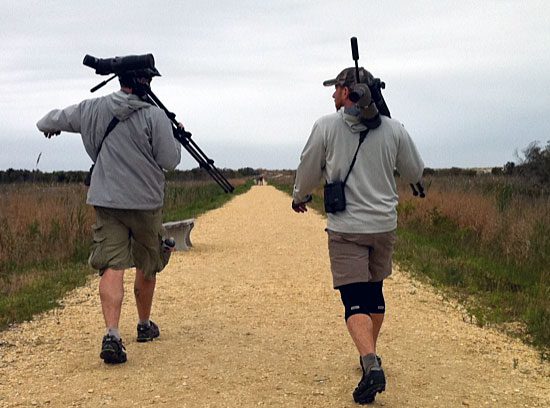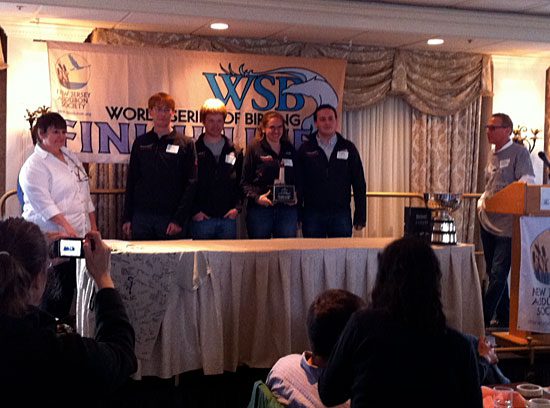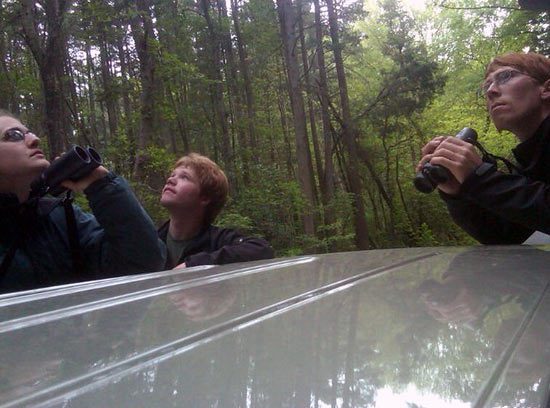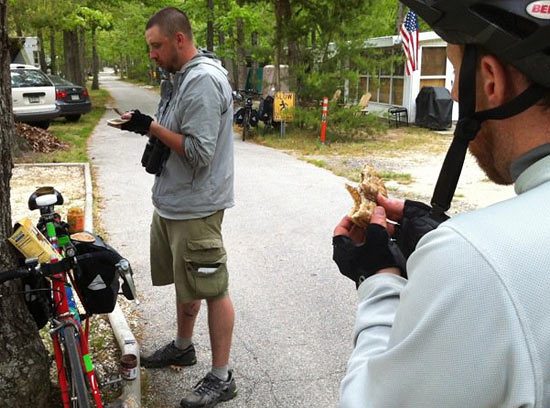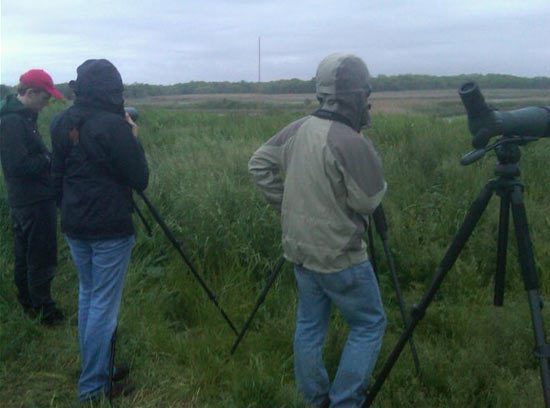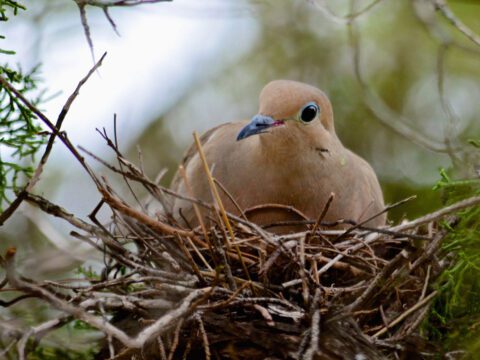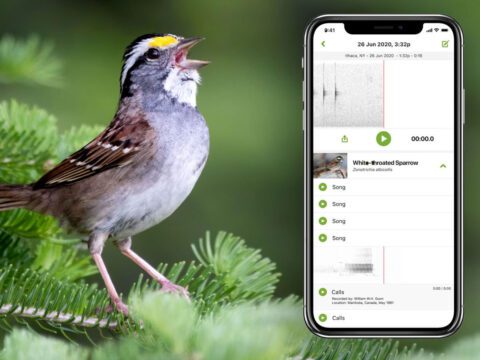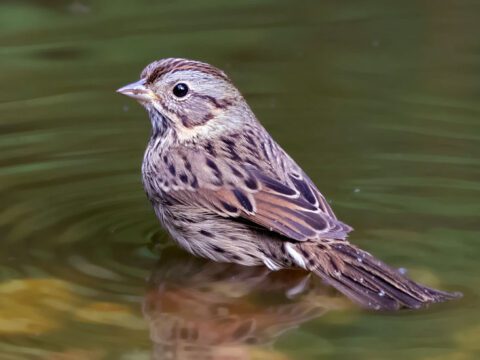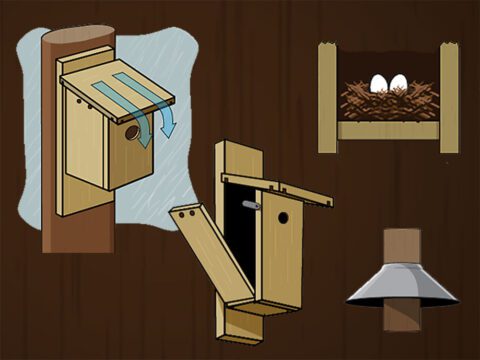Cornell Lab teams victorious in World Series of Birding!
Images by Hugh Powell and Scott Haber May 17, 2011
After 90 miles of riding, the Anti-Petrels take scopes to find Piping Plover and Common Moorhen 
Team Redhead accepting their trophy: Jay McGowan, Andy Johnson, Hope Batcheller, Scott Haber 
At the same location, the Redheads got the waterthrush that the Anti-Petrels missed 
Waiting for a Louisiana Waterthrush that never sang 
Anti-Petrels eat lunch while waiting for a fickle Red-headed Woodpecker 
The Anti-Petrels take a break from traffic to ride a tranquil bike path into Cape May 
Hoods raised against mosquitoes, the Redheads look for Green-winged Teal at dusk
On an overcast and occasionally rainy day in Cape May, the Cornell Lab Redheads and Anti-Petrels found enough good “gets” to offset the painful misses from a slow day of songbird migration. Both teams won their divisions in the 2011 World Series of Birding: the Redheads won Cape May County with 163 species, and the Anti-Petrels won the Carbon Footprint category by riding 100 miles and recording 144 species [view map of bike route]. The Delaware Valley Ornithological Club’s Lagerhead Shrikes won the statewide event with 220 species, and the high-school-age Razorbills won the youth division with 193 species—the third highest species total in the entire 63-team field. Full results are here.
The win for the Cornell Lab teams capped a great spring birding season that started with Team Sapsucker’s new North American Big Day record, set in Texas on April 22nd. All three teams raised money to support the Cornell Lab’s conservation and student research work. Generous supporters have so far helped us raise $200,000 this year (and you can still donate here). Thank you to everyone who donated, read our blog posts, followed our Facebook updates, and cheered us along!
The high point for the Redheads came on a morning seawatch when a Wilson’s Storm-Petrel came within scope range. It’s an open-ocean species that you typically find only if you brave seasickness. There were more good sightings to come, including Common Eider, Red-throated Loon, Belted Kingfisher (a surprisingly hard bird to find in Cape May), and the dainty Bonaparte’s Gull. But there are always unwelcome surprises on a World Series as well, and the team were disappointed to miss Barred Owl during their night birding and White-faced Ibis, a rarity they themselves had discovered just three days earlier, but that refused to show itself for them on Saturday.
My team, the Anti-Petrels, had similarly frustrating stakeouts—the Louisiana Waterthrushes that sing almost constantly in Belleplain State Forest stubbornly kept quiet during the whole time we waited for them. Both we and the Redheads made a special trip to an RV campground for a nesting Red-headed Woodpecker. On Friday the bird checked in within 5 minutes of our arrival, but neither team saw it on Saturday. Red-headed Woodpeckers are one of the most spectacular North American woodpeckers—bold scarlet, glossy black, and gleaming white. This was the second year we made a time-consuming detour just to miss it, and it was painful to let the minutes slip away without seeing it.
A few others did show mercy at the last minute—Soras were quiet in the windy nighttime until their very last chance to call before dawn. Great Horned Owl waited until dawn had almost become day to start hooting. And a Gull-billed Tern we had detoured to get spent 15 minutes hunkered out of sight before finally lifting its pale wings and floating over the treeline into view. Despite the day’s weather and the Yellow-billed Cuckoo’s nickname “rain crow,” it was entirely silent at Belleplain, and we gave up hope on this forest bird as we departed for the saltmarsh. Four hours later we were riding across a causeway as a trim, rufous-winged bird darted out from a low bush. It was a Yellow-billed Cuckoo fighting the onshore winds, dipping past Charles’s front wheel to land in a shrub across the road.
Our best find must have been the Curlew Sandpiper that France picked out of 30,000 dowitchers and Dunlin at Heislerville. These birds breed in far northern Siberia and winter in Africa, Asia, and Australia—but a few periodically turn up on the East Coast during migration. This year, people had found 2–4 Curlew Sandpipers at Heislerville, but we hadn’t been able to find them during scouting. After 20 minutes of scanning the carpet of shorebirds in the mudflats in front of us, suddenly the bird was there, tiptoeing across the dry mud among diminutive Semipalmated Plovers and Semipalmated Sandpipers. The bird was just coming into its rich chestnut-red breeding plumage. I was most struck by its fidgety behavior. The dowitchers stayed in the water, keeping to business, their bills thrust down into the mud, and Dunlin napped with their heads under their wings. But the Curlew Sandpiper held its head high, its curved bill swiveling through the air, looking left and right as if it could discern good patches from bad in the featureless mud. The bird took three or four steps toward shore, darted at something on the ground, and then the head came up again and the leggy bird paced after something else. Schedules are tight on a World Series run, but we all took an extra minute to watch this bird. It was the first one I had ever seen.
We covered a lot of ground to get 144 species, but we were even more inspired by some of our competition—particularly the Monarchists, who limited their route to just half of Cape May itself. Their team features some of Cape May’s very best birders, and they were able to coax 115 species from a route less than 20% the length of ours. Their focus on skill, observation, and thorough coverage—building a rich list from intimate knowledge of a place and its birds—is the most compelling aspect of the Carbon Footprint approach, and one that anyone can emulate, in whatever patch of ground or window of time we have available. Likewise, the Deckcissels won the Big Stay award by getting 80 species without traveling anywhere at all—an impressive total for a day with so few migrants.
Equally inspirational were the performances of the youth teams. Two high-school-age teams placed third and fourth in the overall World Series standings, the Razorbills with 193 species and Bob Merlin & the Railers with 185 species. And my jaw dropped for the second year in a row to hear the totals for the middle-school and elementary-school age groups: Duck Duck Duck Duck Duck Brant! with 140 species and the Merlins with 118 species, respectively. Pretty good for teams whose captains have to lower the microphone and stand on their tiptoes just to give their acceptance speeches.
And then there were the Brick City Nighthawks, a team of 11 kids from Newark. Fairly new to birding, and coordinated by staff from the Newark Museum, they scored 77 species. For conservation to succeed into the future, we’re going to need young people who know their natural history and are ready to pour their enthusiasm into the cause. We’re pretty sure that future birding stars and conservation leaders will come from organized programs such as the ones that participate in the World Series of Birding. The Redheads’ two freshmen, Hope Batcheller and Andy Johnson, are a great example of where talented and devoted young birders can go next. We’re looking forward to meeting more.

All About Birds
is a free resource
Available for everyone,
funded by donors like you
American Kestrel by Blair Dudeck / Macaulay Library
